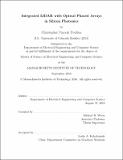| dc.contributor.advisor | Michael R. Watts. | en_US |
| dc.contributor.author | Poulton, Christopher Vincent | en_US |
| dc.contributor.other | Massachusetts Institute of Technology. Department of Electrical Engineering and Computer Science. | en_US |
| dc.date.accessioned | 2017-08-01T13:02:33Z | |
| dc.date.available | 2017-08-01T13:02:33Z | |
| dc.date.copyright | 2016 | en_US |
| dc.date.issued | 2016 | en_US |
| dc.identifier.uri | http://hdl.handle.net/1721.1/110868 | |
| dc.description | Thesis: S.M., Massachusetts Institute of Technology, Department of Electrical Engineering and Computer Science, 2016. | en_US |
| dc.description | This electronic version was submitted by the student author. The certified thesis is available in the Institute Archives and Special Collections. | en_US |
| dc.description | Cataloged from student-submitted PDF version of thesis. | en_US |
| dc.description | Includes bibliographical references (pages 95-101). | en_US |
| dc.description.abstract | Light detection and ranging (LIDAR) has become an ubiquitous ranging technology. LIDAR systems are integral to almost all autonomous vehicles and robotics. Most LIDAR systems today use discrete free-space optical components and utilize a mechanical apparatus for beam steering. Apart from the relative high cost of the system, this mechanical apparatus limits the scan rate of the LIDAR system while increasing both size and complexity. This leads to concerns about long-term reliability, especially in harsh environments. In this thesis, the design and experimental results of an integrated chip-scale frequency-modulated continuous-wave LIDAR system are presented. This system has the capability of measuring both distance and velocity simultaneously with a 20mm resolution and a 2m range. Its functionality is then extended by utilizing optical phased arrays as a transmitter and receiver for solid-state beam steering. The phased array utilized has a grouped cascaded phase shifter architecture and is shown to have a steering range of 46°x36°. This is the first integrated coherent LIDAR system based on optical phased arrays. In order to have a viable LIDAR system with optical phased arrays, high beam powers and large aperture sizes are needed. A silicon nitride distribution network is used to enable high on-chip power because of the low material nonlinearities. An ultra-high main beam power of 520mW is reported. A phased array is demonstrated with an ultra-large aperture size of 4x4mm2, achieving a record-small and near diffraction limited spot size of 0.021°x0.021° with a side lobe suppression of 10 dB. This is the largest optical phased array to date by an order of magnitude and shows the scalability of optical phased arrays. Finally, an optical phased array at a visible wavelength of 635nm is shown with an aperture size of 0.5x0.5mm2 and a spot size of 0.064°x0.074°. This demonstration moves large-scale integrated photonics into the visible spectrum and has potential applications in bathymetric LIDAR. | en_US |
| dc.description.statementofresponsibility | by Christopher Vincent Poulton. | en_US |
| dc.format.extent | 101 pages | en_US |
| dc.language.iso | eng | en_US |
| dc.publisher | Massachusetts Institute of Technology | en_US |
| dc.rights | MIT theses are protected by copyright. They may be viewed, downloaded, or printed from this source but further reproduction or distribution in any format is prohibited without written permission. | en_US |
| dc.rights.uri | http://dspace.mit.edu/handle/1721.1/7582 | en_US |
| dc.subject | Electrical Engineering and Computer Science. | en_US |
| dc.title | Integrated LIDAR with optical phased arrays in silicon photonics | en_US |
| dc.title.alternative | Integrated light detection and ranging with optical phased arrays in silicon photonic | en_US |
| dc.type | Thesis | en_US |
| dc.description.degree | S.M. | en_US |
| dc.contributor.department | Massachusetts Institute of Technology. Department of Electrical Engineering and Computer Science | |
| dc.identifier.oclc | 994684146 | en_US |
